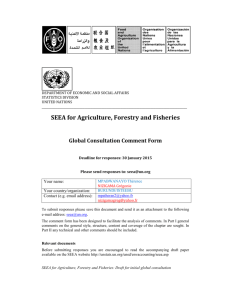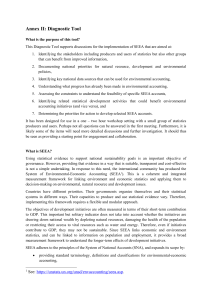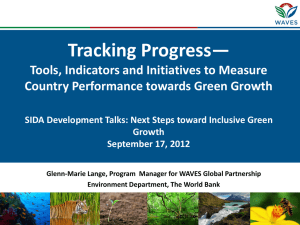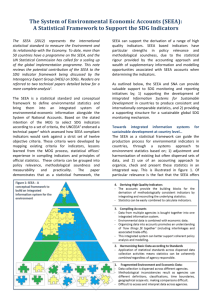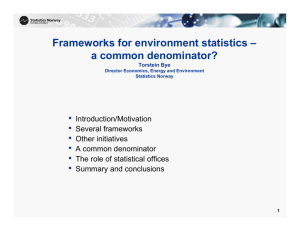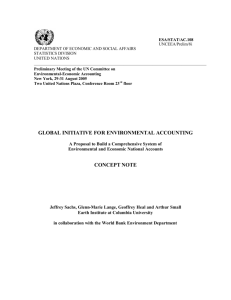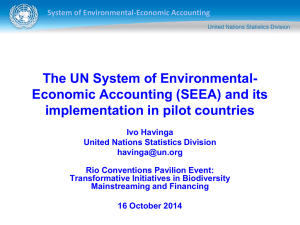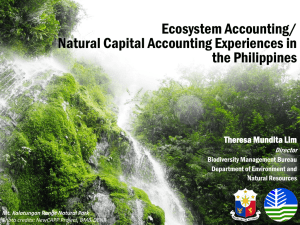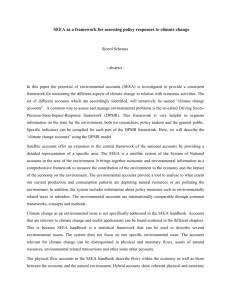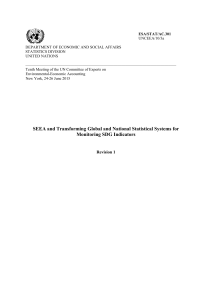How SEEA Contributes to Environmental Sustainability Policies
advertisement
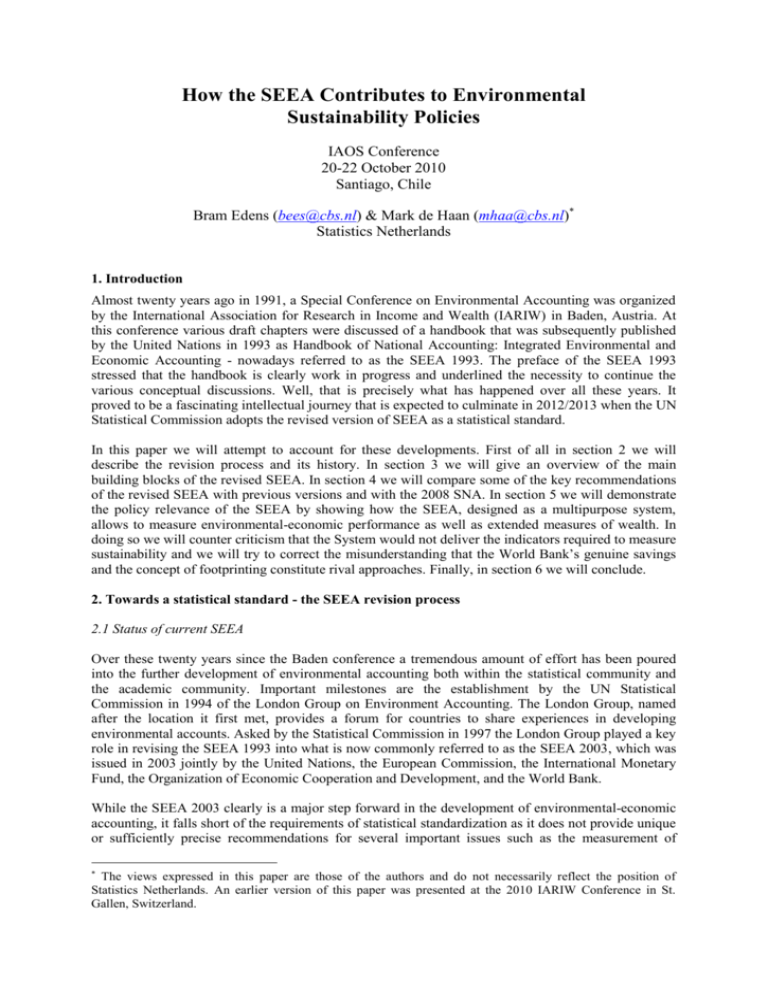
How the SEEA Contributes to Environmental Sustainability Policies IAOS Conference 20-22 October 2010 Santiago, Chile Bram Edens (bees@cbs.nl) & Mark de Haan (mhaa@cbs.nl)* Statistics Netherlands 1. Introduction Almost twenty years ago in 1991, a Special Conference on Environmental Accounting was organized by the International Association for Research in Income and Wealth (IARIW) in Baden, Austria. At this conference various draft chapters were discussed of a handbook that was subsequently published by the United Nations in 1993 as Handbook of National Accounting: Integrated Environmental and Economic Accounting - nowadays referred to as the SEEA 1993. The preface of the SEEA 1993 stressed that the handbook is clearly work in progress and underlined the necessity to continue the various conceptual discussions. Well, that is precisely what has happened over all these years. It proved to be a fascinating intellectual journey that is expected to culminate in 2012/2013 when the UN Statistical Commission adopts the revised version of SEEA as a statistical standard. In this paper we will attempt to account for these developments. First of all in section 2 we will describe the revision process and its history. In section 3 we will give an overview of the main building blocks of the revised SEEA. In section 4 we will compare some of the key recommendations of the revised SEEA with previous versions and with the 2008 SNA. In section 5 we will demonstrate the policy relevance of the SEEA by showing how the SEEA, designed as a multipurpose system, allows to measure environmental-economic performance as well as extended measures of wealth. In doing so we will counter criticism that the System would not deliver the indicators required to measure sustainability and we will try to correct the misunderstanding that the World Bank’s genuine savings and the concept of footprinting constitute rival approaches. Finally, in section 6 we will conclude. 2. Towards a statistical standard - the SEEA revision process 2.1 Status of current SEEA Over these twenty years since the Baden conference a tremendous amount of effort has been poured into the further development of environmental accounting both within the statistical community and the academic community. Important milestones are the establishment by the UN Statistical Commission in 1994 of the London Group on Environment Accounting. The London Group, named after the location it first met, provides a forum for countries to share experiences in developing environmental accounts. Asked by the Statistical Commission in 1997 the London Group played a key role in revising the SEEA 1993 into what is now commonly referred to as the SEEA 2003, which was issued in 2003 jointly by the United Nations, the European Commission, the International Monetary Fund, the Organization of Economic Cooperation and Development, and the World Bank. While the SEEA 2003 clearly is a major step forward in the development of environmental-economic accounting, it falls short of the requirements of statistical standardization as it does not provide unique or sufficiently precise recommendations for several important issues such as the measurement of * The views expressed in this paper are those of the authors and do not necessarily reflect the position of Statistics Netherlands. An earlier version of this paper was presented at the 2010 IARIW Conference in St. Gallen, Switzerland. depletion and accounting for physical flows. The SEEA 2003 can be characterised as a book of best practices, reflecting country experiences, which falls back to providing multiple options when consensus about one recommended accounting treatment could not be reached. In the mean time more and more countries have started experimenting with environmental accounting and in 2006 the statistical community agreed that the experience and knowledge required for standardisation was sufficient to revise the SEEA 2003 in an intergovernmental process in order to become an international statistical standard by 2012 on par with the 2008 SNA. It is fair to say that policy interest in this period went through several ups and downs. An absolute high was of course when the Rio Conference in 1992 in its Agenda 21 called for “establishing systems for integrated environmental and economic accounting in all member States at the earliest date, with the main objective to expand existing systems of national economic accounts in order to integrate environment and social dimensions in the accounting framework, including at least satellite systems of accounts for natural resources in all member States.” † Interest seemed to wane for several years since but has witnessed in recent years a new surge with the organisation by the European Commission of the “Beyond GDP” conference and the publication of the Stiglitz-Sen-Fitoussi report (2009), the report by the joint UNECE/OECD/Eurostat Working Group on Statistics for Sustainable Development (2009), and the Green New Deal (UNEP 2009). 2.2 UNCEEA In order to manage and supervise the SEEA revision process the UN Statistical Commission created the United Nations Committee of Experts on Environmental-Economic Accounting (UNCEEA) at its 36th Session in March 2005. According to its terms of reference‡ its overall objectives are (a) to mainstream environmental-economic accounting and related statistics; (b) to elevate the System of integrated Environmental and Economic Accounting (SEEA) to an international statistical standard; and (c) to advance the implementation of the SEEA in countries. The UNCEEA is described as fulfilling an ‘umbrella function’ in overseeing the work in environmental accounting and related statistics and existing (such as the London Group) or new groups in this field (the Oslo Group on Energy Statistics) are asked to work in a complementary fashion with the Committee. Its members are experts from national governments (de facto of statistical offices) and international organizations. Although the revision process is to a certain extent modelled on the SNA revision process there are several differences. The most important one seems to be that whereas the SNA revision process was steered by the ISWGNA § consisting of international organisations, in the SEEA revision process it is countries that are to a large(r) extent in the driver’s seat. 2.3 Governance of the SEEA revision process It was decided that the revised SEEA will consist of three volumes: volume 1 consists of the international statistical standard; volume 2 consists of those topics for which consensus could not be reached or for which country experiences are limited but which are expected to be highly policy relevant; and volume 3 consists of the applications of the accounts presented in volumes 1 and 2. The revision process started with the composition of a research agenda based upon a wide consultation process. From the research agenda a list of in total 21 revision issues was selected that were considered to be mature enough to be resolved to become part of volume 1 – the standard. Some issues such as the valuation of environmental degradation and ecosystem services will become part of Volume 2. Finally, some issues such as the interrelationship with the social domain – juxtaposing † http://www.un.org/esa/dsd/agenda21/res_agenda21_08.shtml Available at unstats.un.org/envaccounting/ § InterSecretariat Working Group on National Accounts. ‡ environmental pressures or the exposure to pollution with household characteristics such as income etc. or environmental impact of household production - were kept on the long-term research agenda. The London Group plays an important role in solving most of the technical issues on the research agenda. Also the Oslo Group provides advice on the issues related to its work programme. Formally speaking, it is these expert groups that provide recommendations to the UNCEEA which may or may not agree. Subsequently, it is the UNCEEA that provides recommendations to the UN Statistical Commission. By the end of 2009 agreement was reached in the London Group on practically all issues. Outcome papers are being prepared which detail the decisions reached. These outcome papers form the point of departure for the editor who will start writing volume 1 in 2010. Drafts of chapters of volume 1 will be placed on the UNSD website to allow for a global consultation process. SEEA – Volume 1 is expected to be ready for adoption by the UNSC by 2012. Recently, a separate working group focusing on valuation issues steered by the World Bank and the European Environmental Agency was set-up to provide recommendations on various issues relevant to SEEA Volume 2. This working-group consists in addition to several members of the London Group of additional experts from academia and other organisations involved in related programmes such as TEEB (the economics of ecosystems and biodiversity**). The process followed here is similar to that of Volume 1 and Volume 2 is expected to be ready for adoption by the UNSC by 2013. Parts of Volume 3 will be released jointly with Volume I and the remainder with Volume 3. 3. SEEA and its main building blocks This section presents a brief description of content of the revised SEEA as it is envisaged to date.. Like the System of National Accounts (SNA) the SEEA represents a multi-purpose information system that does not follow any particular school of thought. Rather, the SEEA can be used as a basis for monitoring and reporting in support of various policy frameworks, including sustainable development, climate change and other more specific frameworks (such as, SCP, integrated resource management and so on). These elements will be developed more fully in Volume 3 of the revised SEEA. Unlike the SNA, the building blocks of the SEEA do not follow a strict sequence of accounts. SEEA represents building blocks which could be compiled without the necessity of implementing other blocks. SEEA Volume 1 distinguishes the following building blocks. Physical flow accounts One building block of the first SEEA volume represents the accounts on physical flows. This block deals with measuring the use of the environment in terms of natural resource inputs and emissions and waste outputs in physical terms but using accounting concepts and classifications consistent with the economic accounting structure of the SNA. It also sets out general accounting rules relating to physical flows. This building block then provides a separate discussion for each of the main types of physical flows i.e. material, energy, water and emissions. Issues related to each particular type of physical flow are addressed in separate sections of this chapter i.e. issues related to classifications, supply and use of products, various aggregations and relevant bridging issues and accounts (for example, bridge tables for energy accounts to energy balances to IPCC). Bridging is particularly relevant to transform emission and energy use statistics based on a territory registration to the SNA based registration which follows the resident principle. In practice this implies allocating emissions of residents engaged in international transport activities (road transport, shipping and aviation) to their countries of residence. ** www.teebweb.org One crucial feature of the physical flow accounts is their one-to-one relationship to the monetary accounts, especially the SNA supply-use tables. Bringing both pieces of information together, these so-called hybrid flow accounts are a powerful analytical tool for reporting on the environmental performance of consumption and production activity. Firstly, the accounts are able to provide information on resource productivity. Enhancing resource productivity (or resource use efficiency) is considered an important policy strategy for decoupling the consumption of natural resources, the related waste and emission output flows, from economic growth. Secondly, hybrid accounts help to shift the perspective of environmental performance analysis from production to consumption. Aided by input-output models, resource inputs or emission outputs can be reattributed to the end users of product: consumers. These kind of calculations lead to so-called footprint estimates of the amount of natural resources emission outputs required to provide a predefined basket of consumer goods, including those emissions that took place abroad but which are attributed to households via commodity imports. Both types of applications of hybrid accounting are further discussed in section 5. Accounts for environmentally-related economic activities, products and other transactions This accounting block addresses two main areas of interest. Firstly, it shows how expenses related to protecting the environment, as well as expenses related to managing natural resources, can be identified within SNA accounts. It also discusses statistical outputs related to the production of environmental goods and services (i.e. services related to environmental protection and resource management). The explicit identification of these expenses allows an assessment of the costs associated with public and private efforts to undertake environmental protection and resource management. Measuring the production of environmental goods and services allows us to assess the direct value of this type of activity to the economy (i.e. value added, employment etc.). The second area of interest relates to the various economic and related tools increasingly being used by governments to achieve favourable environmental outcomes. Again, the SEEA is essentially drawing out transactions that are included in the SNA but not necessarily made explicit within SNA accounts. It includes taxes and subsidies with an environmental base. It also includes the treatment of quotas / licenses / permits to control access to environmental source and sink functions. Much of the accounting for environmentally-related economic activities, products and other transactions (including concepts, definitions and key classifications) in the revised SEEA will be based on work delivered recently and which therefore reflects contemporary thinking. In particular, it utilises the European System of Environmental Goods and Services Accounts, the Classification of Environmental Protection Expenditure (CEPA) and the Classification of Resource Use and Management (CRUMA) that are at the moment being combined into a single classification. These accounts also describe the redistributive effects of environmentally protection taking into consideration taxes and subsidies earmarked to finance these activities. Asset accounts and the valuation of natural resource assets The third building block examines natural resource assets in general and the measurement of levels and changes to levels for these assets—in both physical and monetary terms. The way we understand and measure natural resource assets is vitally important because in assessing whether economic activity is sustainable or not, it is the natural capital base that we are seeking to maintain over time. The notion of a SEEA asset is described (including the criteria used to determine a SEEA asset) along with asset classifications used in the revised SEEA. This is compared to the SNA asset definition and relevant classifications. This building block also examines how these general SEEA accounting principles apply to various specific natural resource asset types. For each type of natural resource asset it therefore describes such things as: measurement units; relevant conversion factors; relevant classifications and frameworks; how to account for changes to asset levels; and issues unique to each asset type. Specific types of natural resource assets addressed include: land; mineral and energy resources; biological resources (both cultivated and non-cultivated); water and other resources. The assets covered in the first volume largely correspond with the natural resource assets defined in the 2008 SNA This building block also provides a full accounting for natural resource assets in monetary terms— including approaches to valuation of these assets, as well as an accounting for all changes between opening and closing balance sheet positions. It commences the discussion, carried forward in the next building block on resource rent, depletion and income. Techniques for measuring resource rent are outlined. The chapter concludes with a section on measuring changes in net worth—in particular, the impact of various forms of asset change on measured net worth. Full sequence of environmentally-adjusted monetary current accounts This building block outlines the sequence of SNA current and accumulation accounts and describes the various environmentally-related adjustments (principally depletion-related adjustments) applied to these accounts within the revised SEEA. Depletion-adjusted measures of production, income, saving and so on provide a more appropriate basis to account for the use of a country’s natural capital and therefore provide a more appropriate view of the sustainability of present levels and types of economic activity. This building block further develops the accounting for changes to natural resource assets commenced in the previous chapter. In particular, it defines depletion and describes the range of assets subject to depletion. It contrasts the notion of depletion with degradation. It also discusses resource rent, income and depletion—their nature and their inter-relationships—for both non-renewable and renewable natural resources. It describes the treatment of mineral exploration and its relationship with (and implications for) treatment of discoveries of new mineral resources. The case of shared ownership of a natural resource asset is examined and the required accounting treatment is described for both flow and stock accounts. 3.2 Volume 2 – Non standardised accounts Volume 2 will build on a classification of ecosystem assets and services. It will be structured according to the following two building blocks: (a) Ecosystem and ecosystem services accounts; (b) Valuation techniques for measuring environmental benefits and damages and their application in a national accounting context (excluding natural resource depletion which is already covered in Volume 1). 3.3 Volume 3 – Policy uses and applications Volume 3 will present a limited number of key policy issues 1) climate change and other environmental issues 2) resource management and 3) cross-cutting issues such as sustainable development. The main purpose of this third volume is to show how the SEEA accounts contribute to each of these main policy areas. Volume 3 will showcase the analytical usefulness of hybrid accounting, for example in indicator construction (e.g. resource productivity indicators), decoupling analyses and analyses of the so-called indirect effects (e.g. total environmental requirements of household consumption as for example reflected in footprint type of indicators). 4. SEEA – main changes 4.1 Conceptual differences with the 2008 SNA The revised SEEA differs in several important aspects from the 2008 SNA. Firstly, the SEEA recognizes that assets need not necessarily be owned to provide benefits. Furthermore, SEEA interprets benefits not in a strict economic sense as monetized but follows the concept of Total Economic Value (TEV) that distinguishes between use and non-use benefits including for instance option, bequest and existence values. As a result of these considerations, the asset boundary of the SNA is enlarged and a distinction will be made between SNA assets covered in volume 1 and asset beyond SNA scope, covered in volume 2. The SEEA asset classification will be presented differently to better highlight the perspective of the environment, although the details of the classification are still under discussion. Secondly, the SEEA treatment of the recording of depletion of non-renewable natural resources differs from the SNA. Whereas the SNA records depletion as other changes in the volume of asset accounts in the balance sheets, the SEEA will treat depletion similar to the consumption of fixed capital (consumption of natural capital), and subsequently balancing items of the current accounts such as net income and savings will be adjusted for depletion in addition to consumption of fixed capital. Depletion adjusted current accounts will be presented in the SEEA standard (volume 1). After lengthy discussions on the precise measurement of depletion, it was decided that in the absence of market values the net present value (NPV) method should be used where the resource rent will be split into an income element and a depletion element. In case of different owner and extractor of the resource, the financial lease approach will be followed. Third, regarding the treatment of natural growth and depletion of non-cultivated renewable resources, it was decided to consider the excess of natural growth over extraction - for instance in case of wild fish stocks – as production. This changes the production boundary of the SEEA from the SNA’s in which such additions to stocks would enter the system via the earlier mentioned other changes in the volume of assets. Although the distinction between cultivated and non-cultivated assets will be maintained in the revised SEEA classification of assets, the accounting treatment of both asset categories is quite similar. In other instances, the SEEA will follow the SNA, for instance in its treatment of emission permits of carbon dioxide as taxes, as well as the recording of decommissioning costs. 4.2 Most important changes compared to SEEA 1993 and SEEA 2003 i. Different presentations The character and objective of the existing versions of SEEA are very different which has resulted in completely different presentations. The SEEA 1993 is presented as a sequence of extensions. Starting from a basic table that combines the SNA production and non-financial accounts (1); it further disaggregates SNA data to show environmentally relevant details (2); adds physical flows (3); adds imputed monetary flows related to depletion and degradation; (4) and finally possible extensions such as household activities, ecosystem services (5). By contrast, the SEEA 2003 does not follow such a sequencing of extensions, but follows a more modular approach in which chapters are organized along types of accounts (stocks, flows) or subjects. The sequence of accounts and resulting environmentally adjusted aggregates is presented in the end. As explained in section 3, the revised SEEA will also have a modular structure. However, the aim is to strengthen the mutual relationships between the various building blocks and as such strengthening the systems approach the SEEA should represent. Whereas the SEEA 1993 and SEEA 2003 provided numerical examples throughout, examples will be left out of the statistical standard. The revised SEEA will also be more concise and terminologically precise. The scope of the accounts will be illustrated with the help of standardized tables based on a fictive SEEA-land dataset, quite similar to the set up of the SNA table illustrations of accounts. ii. More detailed classifications We see clearly progress between the different versions in the development of more detailed as well as additional classifications. One of the main improvements of the revised SEEA over the SEEA 2003 will be the integration of waste classifications (Waste Statistics Regulation) which will allow to better integrate waste statistics into the System. The Classification of Environmental Protection Expenditure (CEPA) and the Classification of Resource Use and Management (CRUMA) are at the moment being combined into a single classification will also be a major step forward.. iii. Balance physical and monetary accounting Whereas the SEEA 1993 has a relatively large focus on valuation especially regarding environmental degradation, we see that in SEEA 2003 and the revised SEEA physical accounting has become relatively more important. While some countries will be primarily interested in developing monetary indicators such as ‘green GDP’ or extended wealth, others may be more interested in applications of physical flow accounts such as air emissions accounts. This illustrates the development of SEEA towards a system with a more multi-purpose character. A proper balance between physical flow accounting, depletion accounting but also the accounts for environmental goods and services, environmental protection and resource management expenditure will be maintained in the statistical standard as represented in the revised SEEA. iv. Integration with MFA One of the larger changes of the revised SEEA with respect to the SEEA 2003 has been to harmonize and align practices in the recording of physical flows between the environment and the economy with those of Material Flow Accounting. This pertains primarily to the recording of cultivated biological resources, and to a lesser extent the treatment of consumer durables and recording of landfills. The issue is as follows. The growth of cultivated biological resources constitutes a process of production in the 1993 and 2008 SNA as well as the SEEA 2003. As such the SEEA 2003 records it within the economy and considers flows from the environment to the economy to consist of the ecosystem inputs necessary for the growth of the resources for example carbon dioxide, nutrients and soil water. On the other hand, the economy-wide MFA (EW-MFA) approach considers cultivation of biological resources as a process that takes place in the environment and not within the economy. The flow from the environment to the economy in MFA is the harvest of the biological resources. A new convention has been found that proposes to record instead of either the harvest or ecosystem inputs the biomass growth that is used in the economy as physical flow from the environment to the economy. The advantages are that no longer statistically difficult to measure flows of ecosystems inputs would have to be estimated and that the production boundary of the SNA would be respected which is not the case in previous MFA practices.†† v. Valuation of degradation Regarding the valuation of environmental degradation, this is probably one of the most contested issues. Whereas the SEEA 1993 was a strong advocate of maintenance costing, the SEEA 2003 took a more neutral stance and provided multiple options divided into cost based and damage based approaches as well as greened economy modelling. The valuation of degradation and its recording is †† Actually, the convention is a bit more nuanced and does not free us completely from estimating some ecosystem inputs in order to avoid double counting. It reads a) in case the cultivation process is dominated by a natural process in which cultivation occurs under near-natural conditions and in direct interaction with the environment(e.g. plantations) the flows from the environment to the economy consist of the used biomass growth i.e. the biomass that is drawn into the economy; b) in case the cultivation process is dominated by an economic process in which cultivation occurs under artificial conditions and there is little direct interaction with the environment(such as green houses) the flows from the environment to the economy consist of ecosystem inputs i.e. the natural inputs (e.g., nutrients, carbon dioxide) required by plants and animals for growth. still an outstanding issue that needs to be addressed as part of the research agenda of SEEA Volume II.‡‡ §§ vi. Other Other conceptual developments from SEEA 2003 towards revised SEEA are the following: Renewable energy: For hydropower it was agreed that the natural resource (the water reservoir) should be distinguished from fixed assets (e.g. the dam). Water reservoirs which are specifically used for hydropower generation should be classified as renewable energy assets. For solar, wind, thermal and tidal renewable energy sources the LG agreed that resource rents will generally be reflected in land prices and subsequently in land rents. The classification of mineral and energy resources that followed the Mc Kelvey box will be harmonized with the UN Framework Convention for the classification of mineral and energy products. The SEEA will continue to classify soil separately from land in the SEEA classification of assets. However, the resource rent in the (monetary) current accounts of the SEEA will combine the rents of both resources. The depletion element of the resource rent together with actual rent payments on land will be reallocated in the income distribution account from the producer (e.g. farmer) to the land owner. Losses in the productivity of the land as a result of soil depletion (loss) and degradation (quality decrease) are very important and should preferably be charged against gross income and gross saving in the SEEA current accounts of the statistical standard (volume 1). It is still an outstanding issue whether the water contained in artificial reservoirs should be recorded as produced assets. If yes, this would also be a departure form the SEEA 2003. 4.3 Relation to environmental and energy statistics The revised SEEA will follow the residence principle of the SNA in order to guarantee consistency when for example resource productivity or intensity indicators are developed. The revised SEEA will therefore include bridge tables explaining differences in underlying definitions and classifications between energy balances and accounts. Likewise the revised SEEA will explain differences between air emission statistics (following IPCC reporting rules) and air emission accounts following the SNA resident principle. It is interesting to note that the 1993 SEEA took an opposite point of view and advocated ‘to describe economic activities and their relations to the natural environment with reference to the geographical area’ (p.40) on the grounds of data availability. Most of the data availability issues seem to have been resolved by now and several countries have already compiled air emission accounts according to national accounts definitions (resident principle) and classifications (ISIC) for many years. Therefore, the residence principle takes prevalence in the standardized accounts of the revised SEEA. 5. SEEA’s linkage to policy indicators In this section we will illustrate the possibilities and value added of suing SEEA to address policy questions. We will focus on two policy domains, environmental-economic performance and extended measures of wealth. In particular we will discuss criticism of the SEEA that it it does not deliver appropriate policy indicators to assess sustainability. ‡‡ At this stage it appears likely that not one single valuation approach will be recommended outright. Conceivable options could be to formulate conditionalities that would provide a ranking of methods based on conditions or to provide valuation guidance for individual types of asset impacted or for types of pollution (air emissions, noise etc.). §§ The SSF report appears to be in favor of maintenance costing. 5.1 Measuring environmental-economic performance The first policy perspective addresses the measurement of environmental-economic performance, i.e., the extent to which economic growth can be decoupled from resource inputs and pollution outputs. In most countries environmental policy concerns, one way or another, the material throughput of consumer and producer processes. The SEEA is well equipped to monitor trends in eco-efficiency at the macro, industry or households level. Decoupling As mentioned earlier delinking environmental pressures from economic growth is an important aspect of green growth policy strategies (EC 2010; OECD 2010). Since the SEEA physical flow accounts are based on national accounts concepts and classifications, they can easily be connected to the corresponding national accounts supply-use data at national as well as industry branch level (de Haan (2004). This leads to a hybrid type of monitoring system reviewing macro-economic performances. Especially within the EU many NSI’s provide such types of indicators derived from the hybrid accounts. Supplementing ratio indicators simply exposing e.g. changes in resource (energy) productivity over time, the underlying physical flow accounts may assist in explaining the driving factors behind decoupling trends over time. Descriptive (input-output type of) models can be used to entangle the effects of for example population changes, eco-efficiency changes (fuel use per unit of production), input shift changes (from fuel to renewable energy inputs) but also the effects from gradual shifts in economic structures (from manufacturing to service based economies). These kinds of decomposition analyses are a powerful tool in understanding changes in eco-performance over time and will be exposed in the SEEA volume 3. Footprint indicators When we combine physical flow accounts (e.g. emission accounts or water use accounts) with an input-output table, we are able to calculate the indirect (or embedded) emissions as a result of consumption (any final demand category). This technique is called environmentally extended input output analysis. The use of integrated accounts that are based on similar definitions and classifications allows SEEA to switch from a production perspective to a consumption perspective in a consistent way. This means that it ensures that the total amount of emissions attributed to final demand categories equals the total emissions reported in the emission accounts. In the EU two important research projects are currently underway to develop environmentally extended input-output databases in which the accounts per countries are interlinked via international trade data (WIOD*** and EXIOPOL†††). These databases will prove very valuable in the systematic allocation of environmental pressures to consumers worldwide. The ecological footprint (Rees 1992; Wackernagel et al 1999) goes several steps further in (1) converting environmental pressures to land equivalents needed to support the various resource and sink requirements of households and (b) scaling these requirements to the bio-capacity of particular countries (or regions) and (b). As a multi purpose database the SEEA is able to support these kinds of calculations (de Haan 2004), and work is ongoing in order to further integrate both approaches (GFN 2010). 5.2 Extended measures of wealth Asset accounts can be compiled in physical and monetary terms. In physical terms they provide insight in the development of stocks and whether the extraction exceeds discoveries (and re-evaluations). For instance in case of mineral and energy resources, stock accounts can be used to assess the expected lifetime of the resource and whether this lifetime changes over time. Expressed in monetary terms *** World Input Output Database, www.wiod.org A new environmental accounting framework using externality data and input-output tools for policy analysis; www.feem-project.net/exiopol ††† asset accounts provide an estimate of the current value. Time series can then be used to assess whether this value increases over time. These time series can of course be compiled in current or in constant prices. Advocates of strong sustainability will prefer to use physical indicators. A lower total stock could be perceived as indicator of unsustainable behaviour. Alternatively, if this lower physical stock occurs in combination with lower extraction rates which would result in an increasing lifetime of the reserve this could be interpreted as indicating a more sustainable policy. Advocates of weak sustainability may prefer to look at the development of the stock value over time. They may stress that even with decreasing physical reserves, as long as the stock value appreciates due to price changes, policies are deemed sustainable. They will stress that increasing prices reflect increasing scarcity and may cause alternative energy sources to become competitive. The best indicator for sustainability will therefore be stock values that do not decrease in time. SEEA like the SNA does not favour one particular school of thought over another, and consequently, does not advocate one view of sustainable development over the other. Both strong and weak sustainability advocates can derive the indicators from the system as they see fit for their purposes. When stock values for all assets are available we can compile a complete balance sheet for a country.. The SEEA due to its extended asset boundary would include also non-SNA assets (such as ecosystems) which would result in higher estimates of (extended) wealth.‡‡‡ Income defined as the return to wealth would also be larger and would include so-called ecosystem services. As there is little experience so far in measuring these services, this will be taken up in Volume 2. 5.3 Addressing criticism SEEA - previous versions of it - has been criticised over the past couple of years by academia. Especially its use of environmentally adjusted aggregates is generally criticized for failing to address or explain how it relates to economic theory in general and to social welfare or sustainable income in particular, e.g.: “we take the view that the SEEA .. has yet to provide a clear answer about what the system is supposed to measure. It is not a Keynesian style set of accounts for macro-economic purposes, neither does it provide welfare – indices and, as far as we can tell, it does not necessarily produce a measure of sustainable income” (Heal and Kingstrom 2005). In fact this is true, SEEA does not necessarily produce a sustainable income but it nevertheless provides the guidance to do so. For example, volume 1 contains strict guidelines for measuring natural resource depletion adjusted income while volume 2 will provide options for calculating environmental degradation adjusted national income. More recently, the Report by the Commission on the Measurement of Economic Performance and Social Progress (Stiglitz et al 2009), also known as the Stiglitz-Sen-Fitoussi report (SSF report) accuses the SEEA of not delivering indicators that are relevant for addressing sustainability. The report makes a clear conceptual distinction between assessments of current well-being and assessments of sustainability, defined as whether current well-being can last over time. In chapter 3 entitled sustainable development and environment a distinction is made between several approaches: ‡‡‡ Dashboards of indicators; Composite indexes; Adjusted GDPs: greening the national accounts; Adjusted net savings (ANS) or changes in extended wealth; Footprints. Care should be taken here to avoid double counting. When valuing for instance the ecosystem forest, timber values would constitute an of which item. Currently the EEA has taken the lead in developing a classification of ecosystem services. These approaches are subsequently described and evaluated whether they provide the desired policy indicators. We believe the SSF report does not do full justice to the SEEA as it currently stands. There are several aspects that in our view stand to be corrected. First of all, as evidenced by the fact that SEEA§§§ is classified under adjusted GDPs, the report takes a narrow view of the types of indicators that the system has to offer. Essentially the system is reduced to what may have been its primary purpose in earlier versions -green GDP- but as we have illustrated above does not reflect its current multipurpose character. The main point of criticism is however that even if we were to have perfect green GDP measures, it would not tell us whether we are becoming more sustainable or not. In this regard, the World Bank’s adjusted net savings indicator and the ecological footprint indicator are credited for addressing this issue. This is of course correct, but cannot be held against SEEA, as SEEA does not exist solely of environmentally adjusted aggregates but also includes (extended) measures of wealth. The SSF report somehow misses one of the main building blocks of SEEA – the asset accounts. As we have discussed above, changes in wealth (at least according to a weak sustainability advocate) do indicate whether we are over consuming or under investing. The total changes in stocks equals what is called net investment. Second, the SSF report primarily discusses ANS whilst the focus of the World Bank’s work has shifted in the past years towards measuring extended wealth (World Bank 2006).**** The point we want to make here is that rather than seeing the World Bank’s approach as a rival to SEEA and classifying it in a separate category it could be better characterized as an extension of SEEA. Both approaches depart from measures of stocks. The World Bank obviously goes farther in its wealth measurement by including also human/social capital, and in its adjusted savings by also including degradation. But this does not render them inconsistent. The report credits the ecological footprint in being able to convey a clear message however it is also judged to have several methodological issues. A more transparent approach based upon the same idea such as carbon accounting is deemed by the SSF report to be a promising attempt to monitor the demand we place on our ecosystems. It would have the advantage compared to for instance ANS that it attributes responsibility for emissions on the basis of consumption and not production.†††† As was argued in the previous section, the SEEA supports these kinds of analyses. In short, the report emphasizes that rather than singling out one approach, a diversification of approaches is needed. Its recommendation 11 therefore calls for a dashboard of indicators. Prominence is given to wealth measurement, as its components should be interpretable as functions of underlying stocks. Such as dashboard would include a monetary index of sustainability but would have to be supplanted according to recommendation 12 with additional physical indicators. It is our conjecture that SEEA as a multipurpose system will go a long way in allowing for the derivation of the set of indicators that the report calls for. It incorporates both stock based (wealth) as flow based (green GDP) indicators, production based and consumption based approaches, and all of these in monetary and physical units. 6. Conclusions and further work The advantage of using an accounting framework that integrates economic and environmental information is that it guarantees consistency in definitions and classifications between both types of §§§ Erroneously spelled out as System of Eco-Environmental Accounting. The approach followed in World Bank 2006 is that first of all total wealth is estimated as net present value of of (sustainable) consumption in which genuine savings acts as a boundary condition to assess whether consumption is in fact sustainable. When negative genuine savings occur, they are subtracted from savings as available in the national accounts. The value of produced assets is obtained from the SNA balance sheet. Natural capital assets are in most cases estimated by the World Bank. Human/social capital which is called ‘intangible capital’ can then be obtained as the residual obtained after subtracting produced and natural capital from total wealth. †††† As endowments of countries with natural resources are asymmetrical (they seem to be concentrated in developing countries) foot printing would avoid the bias against developing countries inherent in ANS. **** information. Resulting indicators such as energy intensity of productivity will therefore be consistent. That this is not a marginal issue can be illustrated by the fact that the emission intensity of the Dutch economy measured consistently according to the residence concept is increasing, whereas if we simply divide the Kyoto emission figure by GDP (as is commonly done in climate change community) the intensity would drop (CBS 2009). There are several other advantages in deriving policy indicators from an accounting framework: Indicators are subject to checks and balances (supply equals use; value divided by price should equal volume) and as a result have a higher reliability. All indicators derived from the accounting system are consistent with each other. This is especially relevant when several indicators are combined to form a dashboard. It would be unfortunate of one indicator is based upon a different definition of employment than another; or if different expenditure concepts are used. Most indicators can be easily further disaggregated by activity (industry); by sector (ownership); by region (spatially); by valuation (current or constant, basic or producer’s prices); by purpose (functional classifications). Indicators linked to accounts are ready for a range of analytical some of which are mentioned in this paper but will be in more detail exposed in SEEA volume 3. Indicator lists are in this respect rather footloose devises. The revised SEEA is designed to be a multipurpose system that does not favour one school of thought over another and is applicable to any country regardless of its state of development. The revised SEEA does not compete with other approaches such as eco-efficiency indicators or adjusted net savings. Instead it has tried to benefit from established practices and incorporate new insights as much as feasible. An example is that the system boundaries in physical terms between economy and environment have been rearranged to more fully integrate Material Flow Accounts. The restriction of course always will be that although being a satellite system does allow some flexibility to change concepts or boundaries, basic accounting conventions and classifications need to be guaranteed. If not we would loose the advantages that come with being integrated with the System of National Accounts. SEEA is not expected to reach its final state by the year 2012. As the SNA, it will be subject to ongoing revisions and updates. In a next revision some accounts now included in Volume 2 when mature enough could be included into Volume 1. Especially in the relatively new area of ecosystem accounting, a lot of progress is expected in the coming years. New roads to explore are probably: Integration of GIS type of applications that would allow not only very detailed breakdowns of production and income statistics, but also its juxtaposition with for instance exposure to pollutants and its related impact on health Further disaggregation of households into relevant socio-economic characteristics such as household size, income, education. We hope that the elevation of the revised SEEA to a statistical standard will not only give an impetus to environmental accounting, but will provide policy makers and academia with a system that is able to satisfy various policy and research needs. References: De Haan, M., 2004, Accounting for goods and for bads: measuring environmental pressure in a national accounts framework, Voorburg (Statistics Netherlands). European Communities 2010, Europe 2020, A European strategy for smart, sustainable and inclusive growth, Brussels, 3.3.2010 COM(2010) 2020 Global Footprint Network, 2010, Harmonizing the National Footprint Accounts with the SEEA, Paper prepared for the Fifth Meeting of the UN Committee of Experts on Environmental-Economic Accounting, New York, 23-25 June 2010 OECD, 2010, Green Growth Strategy Interim Report: Implementing our Commitment for a Sustainable Future, C/MIN(2010)5 Rees, W.E., 1992. Ecological footprints and appropriated carrying capacity: what urban economics leaves out. Environment and Urbanization (4), 121‐130. United Nations Statistics Division 2008, Historical overview of environmental accounting, http://unstats.un.org/unsd/envaccounting/EnvAcc_Brochure_FINAL1.pdf United Nations 1993, Handbook of National Accounting: Integrated Environmental and Economic Accounting, Statistical Office of the United Nations, Series F, No 61, New York United Nations et al, 2003, Handbook of National Accounting: Integrated Environmental and Economic Accounting 2003, Final draft circulated for information prior to official editing, http://unstats.un.org/unsd/envaccounting/seea.asp UNSD, Progress Report London Group on Environmental Accounting, Prepared by the Chair of the London Group on Environmental Accounting, http://unstats.un.org/unsd/statcom/doc10/BGLondonGroup-ProgressReport.pdf, 2010a Sitglitz, J., Sen, A., Fitoussi, J., Report by the Commission on the Measurement of Economic Performance and Social Progress, 2009. UNECE, Measuring Sustainable Development, 2009. UNEP, Global Green New Deal Policy Brief, 2009. United Nations et al, System of National Accounts 2008. Wackernagel, M., Onisto, L., Bello, P., Linares, A.C., Falfán, L., García, J.M., Suárez, G.A.I., Suárez, G.M.G., 1999. National natural capital accounting with the ecological footprint concept. Ecological Economics 29(3), 375–390. World Bank, 2005, Where is the wealth of nations?
